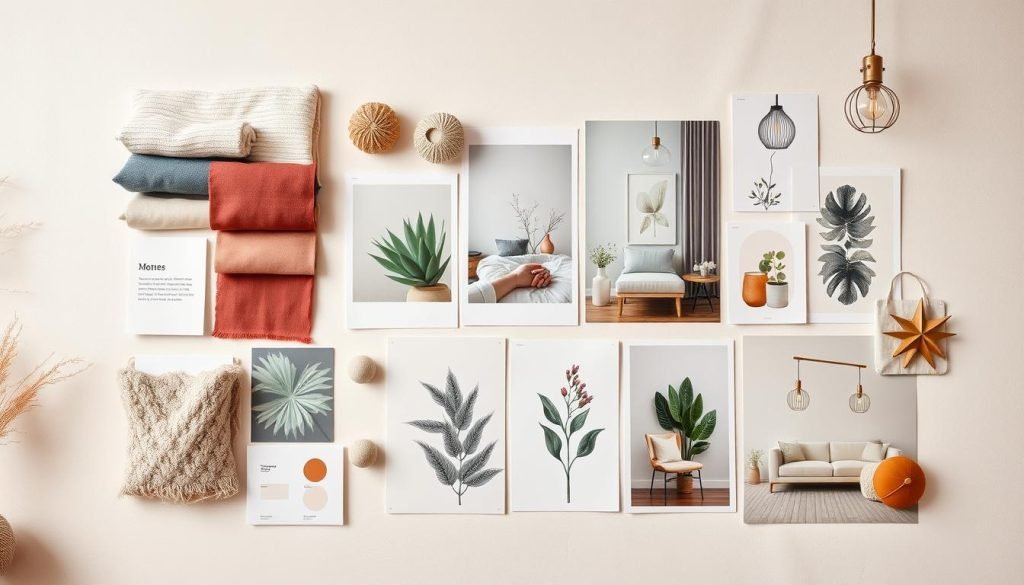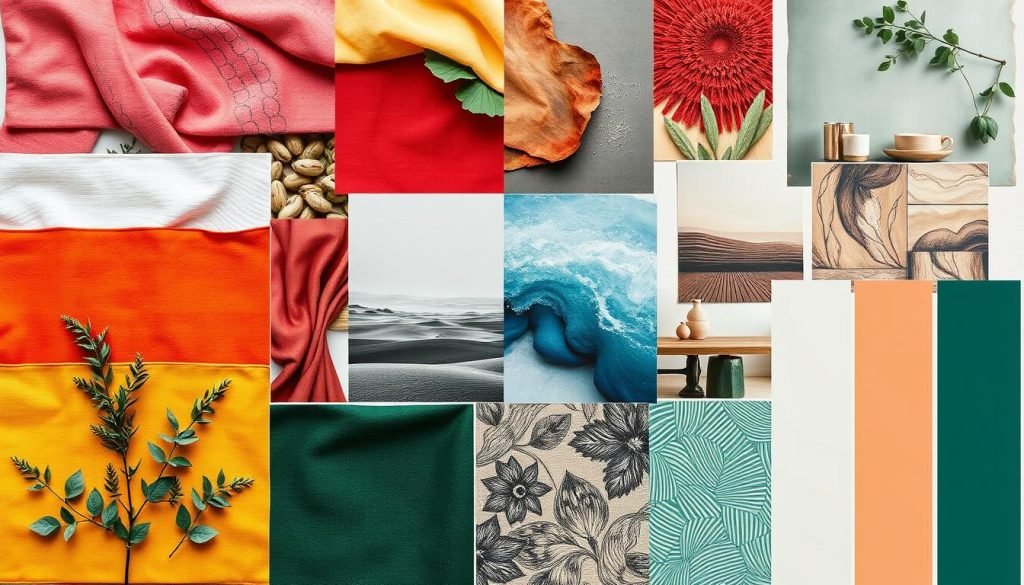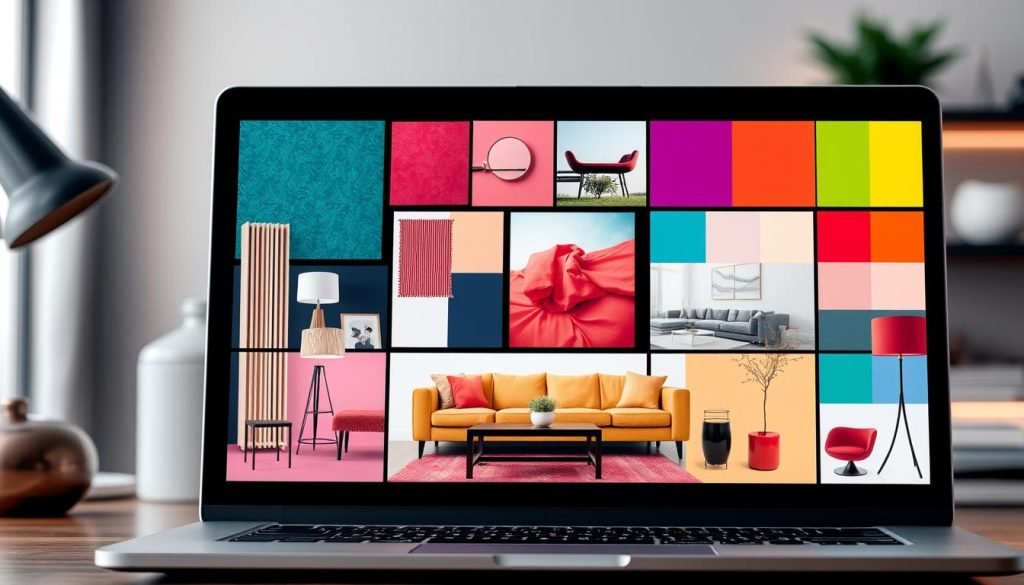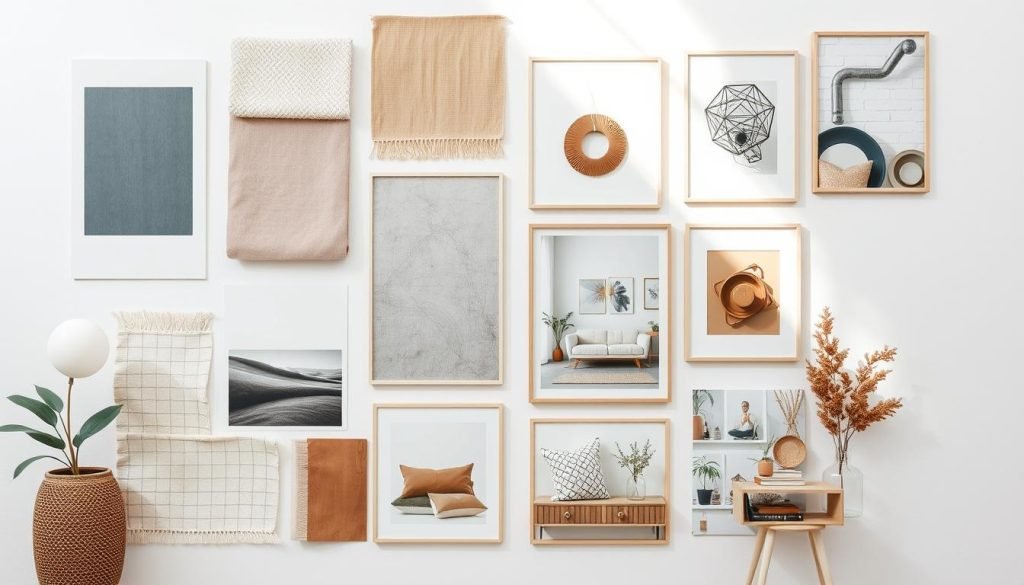Have you ever wondered how designers turn their ideas into amazing visuals? Mood or vision boards are the secret. They help turn abstract ideas into clear design plans. These tools collect images, colors, and textures, guiding any project.
Creating mood boards helps organize your ideas and work better with others. They’re key for brainstorming and finalizing designs. Let’s see how to make mood boards that match your vision.
Key Takeaways
- Mood boards encapsulate themes, colors, and styles for clear project direction.
- Digital mood boards facilitate remote collaboration through video integration.
- Platforms like Canva and Pinterest are popular for creating mood boards.
- Creativity flourishes when focusing on specific themes or constraints.
- Utilizing typography galleries enhances the visual appeal of mood boards.
- Capturing photos on the go makes mood board creation accessible anytime.
The Importance of Mood Boards in Creative Projects
Creating a home décor vision board is an excellent way to visualize and plan your interior design projects. Here’s a concise tutorial to guide you through the process:
- Gather Inspiration: Collect images, color swatches, and materials that resonate with your desired aesthetic.
- Choose a Platform: Decide between a physical board using magazines and printouts or a digital platform like Canva.
- Organize Your Selections: Arrange your collected items on the board, grouping similar themes and colors.
- Refine Your Board: Edit and adjust the layout until it aligns with your vision.
For a visual demonstration, you can watch the following YT video from The Latina Next Door:
https://youtu.be/b4R79ARAV6I
Visual Motivation for Goals
Making a mood board opens up a world of inspiration. It helps to pick the right colors, themes, and textures for any project. Including many images is good, as it brings many ideas.
One powerful image can often be more effective than many similar ones. This focus helps to stay on target, whether working alone or with others.
How Mood Boards Enhance the Design Process
Mood boards make it easy to share ideas with my team. This teamwork can happen at the same time or later, making them very useful. Using a mood board early sets the stage for a project’s development.
Many designers, like those in user-interface and visual design, find mood boards invaluable. They are used in branding, graphics, fashion, and interior design, showing their wide appeal.
| Benefit | Description |
|---|---|
| Visual Inspiration | Mood boards provide diverse imagery for texture, color, and theme ideas. |
| Accountability | They help maintain focus on design goals and client expectations. |
| Team Communication | Mood boards ensure alignment of ideas and design direction in groups. |
| Process Engagement | They engage multiple contributors, enhancing collaboration and input. |
| Clarity of Vision | Incorporating distinctive imagery leads to a clearer overall design theme. |
| Practical Reference | Printing out mood boards allows for easily accessible reference during design. |
Understanding Mood Board Creation

A mood board is a key tool for capturing a creative vision. It shows concepts and inspirations that guide a design project. Knowing about mood boards helps me see their importance in creative fields.
What is a Mood Board?
A mood board is a visual collage of images, colors, textures, and text. It’s crucial in interior design, linking ideas to real results. It lets you share your vision clearly, making sure everyone understands the project’s look and theme.
The Various Types of Mood Boards
There are many types of mood boards for different needs:
- Physical Mood Boards: These boards use materials like fabric and paint samples. They give a hands-on experience for clients and team members.
- Digital Mood Boards: Tools like Style Sourcebook and Piktochart make creating boards easy. They offer lots of images and design elements, helping with creativity.
- Theme-Based Boards: These focus on specific themes, like colors or seasons. They show a clear direction for a project.
Digital tools make it easy to change my mood boards as ideas grow. Each type of mood board is a special way to gather inspiration and define a vision. Your vision can be shared with your partner, friends, or family to bounce ideas to find clarity around your thought process.
Essential Elements of a Mood Board

Creating a mood board is all about picking the right elements to show your design vision. First, you gather visual inspirations like fabric swatches, furniture styles, and colors. These are the basics of your mood board.
Collecting Visual Inspirations
Finding the right visuals can be exciting. You might use Pinterest or Google Images to find images that match your mood. Photos, artwork, and more can all help tell your story.
Incorporating Textures and Colors
Adding textures and colors makes your mood board come alive. Mixing smooth fabrics with rough woods and bright colors makes a big difference. For example, combining matte and glossy textures creates a striking contrast.
By carefully choosing these elements, you can share your design dreams in a real way. Using textures and colors helps set the mood and guides the project’s direction.
| Essential Element | Description |
|---|---|
| Visual Inspirations | Images that capture the design vision and mood. |
| Textures | Diverse materials to convey depth and interest. |
| Colors | A curated palette that aligns with the overall design theme. |
| Consistent Imagery | Photos and designs that are cohesively themed. |
| Storytelling Elements | Visuals that narrate the feeling and concept behind the design. |
Mood Board Creation: Practical Steps to Follow
Creating a mood board is a key step in any design project. It’s important to have a clear process. This helps organize your thoughts and stay focused on your vision.
Setting Your Project Direction
Begin by setting the project’s direction. Having a clear vision is crucial. It shapes the mood board’s theme and content. This step keeps the project on track with my goals.
Gathering Existing Materials
Then, collect materials that match your vision. This includes textures, colors, and design elements. Adding these to the mood board makes it more engaging and impactful.
Adding Inspiring Imagery
Images are the core of a mood board. Choose pictures that capture the emotions and ideas you want to share. This stage brings your vision to life, making it easy for others to understand.
Using Technology for Digital Mood Boards

In today’s world, making digital mood boards has changed how you work on design projects. There are many tools out there that make it easy to bring your ideas to life. With the right software, you can see your ideas come together fast and make changes quickly. This helps when working with others and being more creative.
Top Mood Board Software Options
- Canva: An intuitive platform with a user-friendly drag-and-drop interface for effortless organization. This is my go-to app.
- Pinterest: A fantastic resource for gathering inspiration and visual elements from a vast image library.
- Adobe XD: Ideal for web design projects, offering features for integrating typography, colors, and textures.
- Photoshop: A powerful tool for more advanced image manipulation and detailed mood board creation.
Benefits of Digital Mood Boards Over Traditional Ones
Switching to digital mood boards brings many advantages that make designing better:
- Instant adjustments: Making changes quickly without dealing with physical stuff saves time.
- Easy sharing: Sharing digital boards for feedback helps make decisions early on.
- No storage constraints: Digital boards don’t take up space, so I can keep lots of projects without worry.
- Visual references: They are a guide throughout your project, keeping everything aligned with your vision.
Creative Mood Board Ideas to Spark Inspiration

Exploring theme-based boards can open up new creative paths. By focusing on themes like seasonal changes or color trends sparks interesting ideas. These ideas help shape the vision for new projects.
Theme-Based Mood Boards
Theme-based boards help tell a story visually and guide the project’s direction. Collect elements for a theme and see how they work together. Using different materials, colors, and textures keeps the mood board aligned with the desired vibe.
This method can keep you inspired and focused on the project’s goals.
Fashion and Interior Design Examples
Fashion mood boards often share similarities with interior design, showing patterns, colors, and textures. Looking at fashion mood boards helps with interior design, revealing trends and styles. By seeing how fabric swatches or illustrations are used in both can create unique ideas.
Designing a Professional Mood Board

Creating a mood board is a fun journey that lets you show your design vision. It starts with making a cohesive look that connects all parts smoothly. Each image or color swatch should blend well with the next.
Choosing the right visuals is key to making the board look good. It helps share design ideas and concepts clearly.
Crafting a Cohesive Look
A cohesive design is essential for making individual parts work together. For your mood board, focus on a few key things:
- Color palettes that evoke specific emotions and align with the project’s theme.
- Textures and patterns that add depth and interest.
- Consistent styles of imagery that reinforce the overall mood.
- Strategic layout and organization to guide the viewer’s eye.
By carefully combining these elements, create a mood board that looks great and clearly shows your design’s intent.
Utilizing Typography and Font Choices
Typography choice is vital in setting the mood of your board. The right font choices can make a big difference. Think about:
- Pairing fonts that complement each other to create a consistent feel.
- Using different sizes and treatments (bold, italic) to emphasize key elements.
- Ensuring readability while maintaining aesthetic appeal.
Also, use Canva for easy access to fonts and design tools. It helps make a mood board easily and fast in about 15 minutes. This platform lets you combine stunning visuals and compelling typography, strengthening the design’s message.
How to Use a Mood Board Template Effectively

Using a mood board template can turn a vague idea into a clear vision. Picking the right template is crucial. It becomes the base for a unique style. Customize it to show your ideas, making your inspirations come to life.
Adjusting Templates for Personal Styles
When you start with a mood board template, make it your own. Add photos, colors, and fonts to match your style. Here are some steps to adjust templates:
- Select a template that fits your vision.
- Add your favorite images to represent your ideas.
- Try different colors, thinking about their meanings.
- Use textures and patterns that fit your theme.
- Add notes or phrases to share your vision.
Best Practices for Template Usage
Following best practices keeps my mood board useful. Save your work often and make backups. This way, you won’t lose your progress. Keeping it clean and organized helps you to see your vision clearly. Here are more practices to follow:
- Use about 8-15 images to stay focused.
- Choose textures and images carefully.
- Share my mood boards for feedback.
- Don’t include other brands’ logos to stay original.
- Listen to music while creating to get inspired.
Gathering Mood Board Inspiration

Finding the right mood board inspiration is key for your creative projects. Look for different resources to spark new ideas and shape your vision. These sources help to see the latest styles, making your design work more fun and productive.
Resources for Finding Fresh Ideas
Check out design blogs, interior design magazines, and online sites like Instagram and Pinterest. Each one gives a unique view, showing many styles, colors, and textures. For example, Pinterest lets you save images that match your style, creating a personal collection to go back to.
Exploring Online Platforms for Visual Collecting
Online platforms help make a cohesive mood board. Use tools like PicMonkey, Canva, and Morpholio Board to mix different elements. Choose images with simple backgrounds for a clean look. This makes it easier to put your mood board together.
Organizing your ideas online makes the process simpler. It keeps everything in one place for easy access later.
Real-Life Mood Board Examples
Looking at real-life mood boards gives us great insights into design. They are like guides that help spark our creativity. By studying interior design examples, we learn how experts share their ideas through mood boards.
Case Studies from Interior Design
Interior design case studies show how mood boards help designers share their vision. They use colors, patterns, and textures to tell a story. For example, a modern kitchen design board might use Adobe Photoshop for easy changes.
Research shows that 85% of interior designers start with digital mood boards. This helps them pick colors and set the project’s direction.
Creative Industries Utilizing Mood Boards
Mood boards are key in many creative fields, like fashion and graphic design. Graphic designers use them to match their ideas with what users want. A fashion mood board might include fabrics and colors to show a brand’s style.
Both digital and physical mood boards are used in these industries. Seeing how others use mood boards helps us share our ideas better.your
Conclusion
Throughout your journey of interior design, mood boards are key. They help bring your vision to life and make projects smoother. A good mood board sets the visual direction for your designs.
Mood boards let me try out many ideas and make choices that bring everything together. They give you a space to explore without judgment. This summary shows how important it is to gather inspiration, organize, and get feedback to perfect your designs.
Mood boards are crucial for making any home decor project better.
This post contains affiliate links. If you click on them and make a purchase, I may earn a small commission at no extra cost to you. Thank you for supporting my site!

